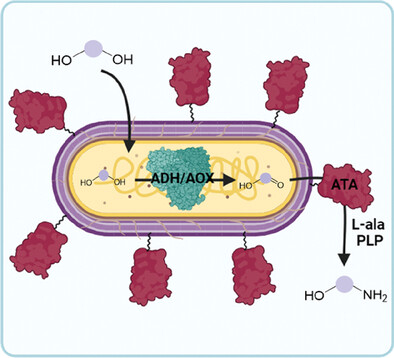Cells exhibit diverse structural formations such as biofilms and spores, enabling them to acquire novel functionalities. Many of these structures display biomacromolecules, including enzymes, tethered to cell walls to support various extracellular processes. Alternatively, encapsulating single cells with polymer coatings offers a strategy that circumvents the need for genetic engineering while imparting artificial functionalities to cells. Here, a universal method is presented for encapsulating single gram-negative microbes with polymeric coatings based on the ancestral gall ink formed by tannic acid-iron complexes. As a result, synthetic spores are achieved that selectively bind His-tagged enzymes through the formation of unprecedented galloyl/imidazole-Fe2+ complexes via ligand substitution demonstrated by density functional theory. These synthetic spores with a thickness of 41.5 ± 4.2 nm and a stiffness of 6.0 ± 3.5 GPa serve as biocatalytic materials for the one-pot oxidative amination of diols into amino alcohols, facilitated by the cooperative catalysis between intracellular endogenous or recombinant oxidoreductases, and an extracellular transaminase from Pseudomonas fluorescens displayed at the spore surface. These spores maintain their performance in three consecutive batch cycles. Integrating isolated enzymes onto the surface of engineered microbes coated with polymers offers novel opportunities for synthetic biology, advancing the efficiency of biosynthetic cascades in solid-state environments.

